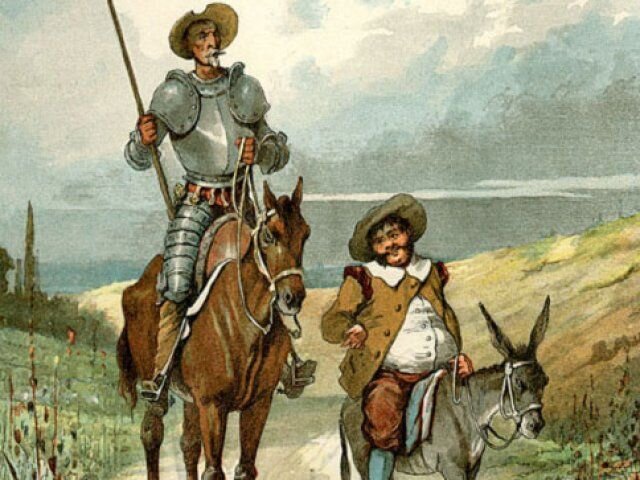Upgrade Your Reading Comprehension With These Books Studied By Spanish High Schoolers
by Brian Alcamo
What books do Spanish students read in high school?
Back to school season is upon us. That means that hoards of high school students are returning to their desks, still salty and sandy from the summer. With grades once again being a source of concern for most, they’re bound to get back to a familiar assignment: reading. Here in the US, most high school students are familiar with a few titles, such as The Great Gatsby, To Kill a Mockingbird, and The Catcher In The Rye. These classics unify our often disparate education system (so does algebra, but we’re more keen on the ~written word~ here). But what do students in Spain read? And can you incorporate these works into your Spanish learning? Let’s find out with these Spanish high school classics.
Part One: Obligatory Historical Classics
According to Bea, one of our native Spanish instructors, “everyone in Spain knows these titles and studies some parts of them, but not everyone has fully read them.” Most of these books are… old. Bea says that the books in their most original formats aren’t recommended for Spanish learners. Because of their age, they’re difficult to read front to back, and even native Spanish speakers will often misunderstand the vocabulary and syntax (think about if you’ve ever had to read Beowulf, I bet your teacher was very forgiving about effort). If you want to experience the story, there are tons of learner versions available.
Don Quijote de la Mancha - Miguel de Cervantes (1605)
While Spanish students don’t always have to read this work all the way through, it is usually thought of as the most important book in the Spanish literary canon. Considered the first modern novel, students will study pieces of the book and learn its plot (which follows a noble-turned-knight-errant on a quest to revive chivalry), even without reading it all the way through. Its language is dastardly difficult, so students who do end up reading it all the way through will typically do so with an adaptation. Here’s an adaptation for Spanish learners at the A2 level!
Don Quijote de La Mancha
La Celestina - Fernando de Rojas (1499)
La Celestina follows a young man pursuing a young woman who employs the magical help of a local procuress, named Celestina, who has a reputation for convincing young women to accept the love of the men who crush on them. Raunchy and witchy for the era (we’re talking peak Spanish Inquisition), the book’s sexual bent remains subversive even to this day. While sometimes regarded as the first novel, though not as adamantly as El Quijote is, many believe it to be more of a piece of dramatic literature, since it is composed almost exclusively of scenes of dialogue. The work has been performed and staged all over the world.
El Lazarillo de Tormes - Anonymous writer (1554)
La vida de Lazarillo de Tormes y de sus fortunas y adversidades (The Life of Lazarillo de Tormes and of His Fortunes and Adversities) is a Spanish novella that follows Lazarillo, who spends his youth as a blind beggar’s apprentice. Subsequent chapters follow him as he works for priests, squires, and friars. La vida’s claim to fame is being the first Picaresque literary work, a satirical genre that follows a picaro or “rogue” who gets by in a corrupt society by using their wit. Containing collections of mini episodes rather than one overarching narrative, picaresque novels attempt to expose social injustices in humorous ways. An English-language take on a picaresque novel is Mark Twain’s The Adventures of Huckleberry Finn.
El Lazarillo de Tormes
La vida es sueño - Calderón de la Barca (1635)
La vida es sueño (Life is a Dream) is a play emblematic of the Spanish Golden Age drama, which lasted from around 1590 until 1680. The play follows Segismundo, the (fictional) prince of Poland, who is locked up in a tower by his father, (fictional) King Basilio because of a prophecy saying that the prince would wreak havoc on Poland and cause the king’s demise (by demise we mean death). Segismundo is let out of the tower for a brief period before being locked up again, and he is convinced that this brief period of time extramuros was simply a dream (hence the title). The play is consistently studied as one of Calderón’s best works, and was recently listed by the Independent as one of the 40 best plays of all time.
Vocabulary To Help You In the Library
Lectura obligatoria - Required reading
Comprensión de lectura - Reading comprehension
Pistas de contexto - Context clues
Personaje principal - Main character
Escritor - Writer
Part Two: Less Obligatory Popular Contemporary Titles
Spanish students aren’t relegated to titles that may feel a little bit antique, they also read more contemporary works as well. These books aren’t as obligatory across the entire country, but are very common.
Works by Spanish Authors
La casa de Bernarda Alba - Federico García Lorca ()
La casa de Bernarda Alba, or The House of Bernarda Alba is a play by Federico García Lorca that follows a family of six women (five daughters and one mother) after the death of their father. Bernarda Alba, the matriarch of the family, imposes an eight-year mourning period on her daughters, and makes it her business to ensure that all five daughters are sad all the time mourning their father both in public and in private, black dresses and all. When the prospects of love and sex come up for the sisters, the play errupts into a debate on repression, passion, tradition, and conformity. Lauded for its exclusion of on-stage male characters, the play ups the ante when it comes to dissecting what it means to be a woman looking for the company of a man.
El camino - Miguel Delibes ()
El camino, or The Road, is author Miguel Delibes’ third novel. It follows a boy who moves from the Spanish countryside to the city. It deals with themes such a nature versus city life and deconstructs the social mores that come with urban existence.
Nada - Carmen Laforet (1945)
Considered one of the most important Spanish literary works of the twentieth century, Nada (Nothing) is an existentialist novella that examines Spanish economic stagnation and the poverty felt by Spaniards on a day to day basis after the end of the Spanish Civil War. The novella takes place in Barcelona, and follows eighteen year-old Andrea as she spends her first year at university living with her aunt and uncle.
Fun fact: the book is considered the Catcher in the Rye of Spanish literature!
Nada
Works by Latin American Authors
While Spain has its own distinct literary traditions, Spanish teachers understand that some of the greatest Spanish-language works come from Latin America. Here are four books that have crossed the Atlantic to teach Europeans a thing or two about what goes on in the Spanish-speaking parts of the Western Hemisphere.
Cien años de soledad (1967, Colombia)
Cien años de soledad (100 years of solitude) is a renowned novel from Colombian author Gabriel Garcia Marquez that follows a family headed by patriarch José Arcadio Buendía, who founded the fictional town of Macondo. The book’s magical realist style positioned it as a classic work in the Latin American Boom literary canon, combining European modernism with the Cuban Avant-garde style.
El túnel - Ernesto Sabato (1948, Argentina)
El tunel is an existentialist novel that explores the twisted psyche of Juan Pablo Castel, a painter from Buenos Aires, as he tumbles into the pitfalls of romantic obsession.
Sor Juana de Inés de la Cruz o Las trampas de la fe - Octavio Paz (1989, Mexico)
At the height of his career, Octavio Paz was the top poet and writer in all of Mexico. His work Sor Juana Inés de la Cruz o Las trampas de la fé (Sister Juana of Inés de la Cruz or The Traps of Faith) explores the life of Sister Juana, a renowned poet and nun from a different century, back when Mexico was known as New Spain. Sor Juana begins her adult life (at the age of fifteen) as the virreina’s protegée. After spending five years at her court, she joins a convent for life, turning the cloistered abbey into a salon with intellectual reaches across the entire hispanophone world. His account of her fascinating life attempts to answer the question of why a woman with such intellectual gifts would become a nun, explorig the patriarchal traditions of New Spain and the annals of seeking feminine freedom behind the walls of the Catholic Church.
A portrait of Sor Juana Ines de la Cruz
Pedro Páramo - Juan Rulfo (1955, Mexico)
Imagine returning to your hometown to visit your father after your mother’s death only to find that the town is inhabited exclusively by ghosts. That’s exactly what happens to this book’s eponymous protagonist, Pedro Páramo. Written by Juan Rulfo in 1955, the book’s reception was initially lackluster, selling only two-thousand copies in its first four years of being published. After some time, the book reached mega-popularity and acclaim. Gabriel Garcia Marquez (see above) credits the book for getting him out of his writer’s block and being the catalyst for his own obra maestra Cien años de soledad.
Thanks For Reading!
Thinking of reading even more? Reading in your target language is a fantastic way to improve your skills. Check out one of the books we mentioned in this post, and be sure to share this list with your friends!





